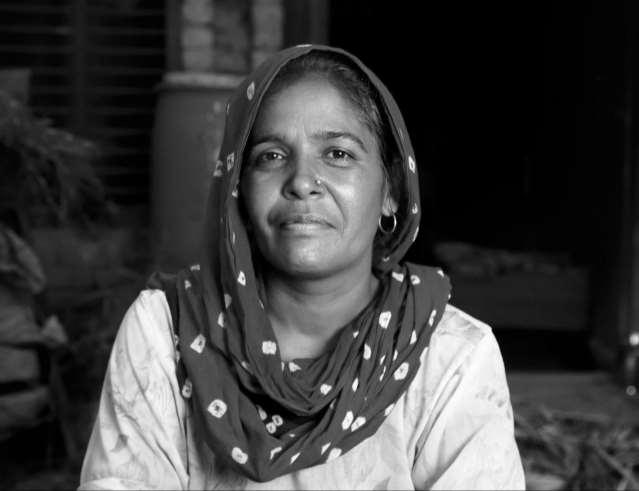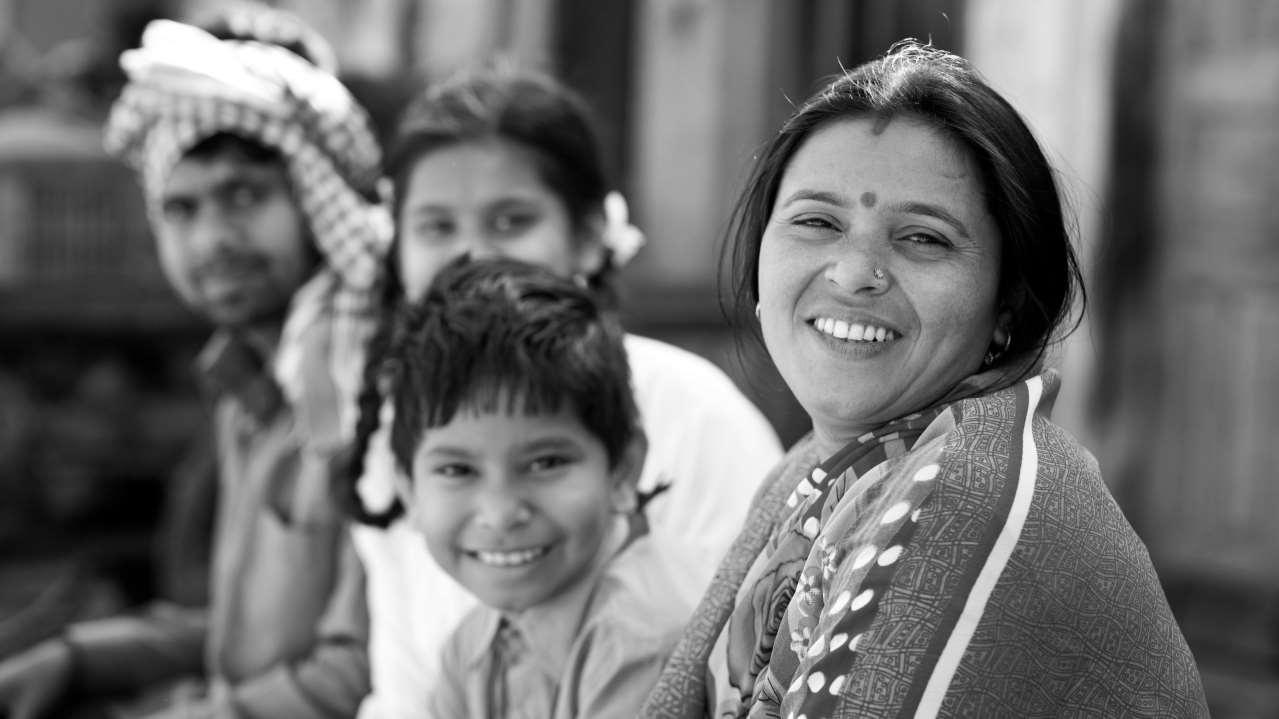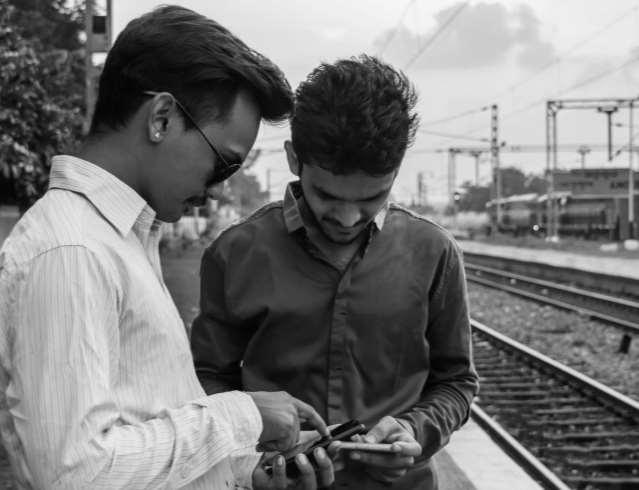Unlocking Digital for Bharat

$50
Billion Opportunity

TABLE OF CONTENTS Introduction 03 Executive summary 04 Untapped potential 05 Decoding barriers 13 User interventions 39 Business implications 57 1

2
Introduction• While India has made significant progress in enabling internet access for its population (lower data prices, cost of smartphones coming down, etc.), large disparities exist in internet usage across:
– Demographics and socio-economic classes (across gender, rural/urban, income groups)
Type and nature of internet usage (content consumption, service transactions, product transactions, etc.)
• We believe the next wave of innovation in India needs to focus on serving the unique needs of 500M+ population base, which is either using the internet or making a transaction on the internet for the first time
• This research focused on developing insights on understanding key user barriers and interventions required across various stages of the user journey, with the following objectives:
– Understand the barriers preventing new users from coming online and existing users transacting online
Define potential interventions required to enable existing users to use the full power of the internet
– Highlight implications for businesses

3
Executive summary
Untapped potential
India has the second highest active Internet users, with about 390 million residents who use the web at least once a month. The country has also experienced the highest increase in internet users, with an average of 40 million beginning gaining access each yet. Further, mobile data use (~8 GB per subscriber each month) has reached the level of developed markets.
But challenges remain. Compared with China and Brazil, India’s penetration of 28% falls behind the 64% in Brazil and the 53% in China. Internet access across demographics varies widely with 55% penetration in urban areas vs. just 15% in rural areas. Also, 33% of men have internet access compared with only 22% of women. Additionally, online retail spending is low—$224 per individual buyer per year—almost one-tenth of the ecommerce spending in China
Decoding barriers

More than 500 million new internet users and online shoppers will gain access, but barriers exist. For example, the access is not equitable across socioeconomic classes. Of the 390 million internet users, 80% are from the relatively affluent NCCS segment A, B and C alone. The lower income NCCS D and E segments have a mere 13% penetration vs. 73% across NCCS segment A. The number of users making online transactions is small: Of the 390 million users, only 40% make purchases online. 90% of that base is from NCCS segments A, B and C.
Because 60% of users (or 230 million) go online for product research and content but prefer to make purchases offline, there is a major opportunity to unlock that broader user base. But the journey to becoming a regular user requires building trust: Typical users take three to four months from their initial internet access to their first transaction. The more time they spend online, the more their trust increases. New users make just 27% of purchases online, but users who have been online for two or more years make 61% of their purchases via online channels.
It is critical to engage and retain users with relevant content. A large number of transactors (54 million) from NCCS A, B and C segments actually drop out after making a purchase, indicating a large opportunity to re engage with these set of users to broaden the transaction base.
User interventions
Four actions can increase awareness, use and transactions among current users and the next set of online shoppers. First, government and private partnerships can create access, awareness and literacy, enabling 370 million people in NCCS segments A, B and C and many more across NCCS segments D and E to get online. Next, locally relevant solutions across content and use cases will improve user engagement and unlock those 130 million new users by doubling internet penetration in rural areas and increasing women’s participation. Third, creating an ecosystem for the self employed to diversify and augment income via digital will be influential on the nearly 40% of the workforce across 46 million micro, small and medium enterprises. Finally, improving trust with an omnichannel presence will increase purchase consideration, transactions and retention. Trust will also reinforce product quality in brand messaging and ease concerns about product returns by redefining return policies and messaging around them.
There is a $50 billion-plus potential that could be unlocked via these new users and reengaging users who have dropped out.
Business implications
Profitability and scale will take time. Tech enabled businesses should brace for the long haul and implement alternate monetisation strategies. Consumers’ willingness and ability to spend online will be low over the medium term, limited by low GDP per capita. Businesses will need to find frugal and innovative ways to sustain themselves over the longer term and at the same time, should consider alternate monetisation approaches beyond consumers. 1
4
Active user: Used internet in last 1 month 2 NCCS: New Consumer Classification System
Untapped potential

5
substantial room for growth (28% penetration)
Strong growth trajectory in building a 390 million Internet user base, with large growth headroom.
About one in five people in India currently owns a smartphone. This number has doubled since 2014 and is projected to cross 400 million (nearly 30% of the population) over the next three to four years.
While the number of 3G/4G subscriptions in India has quadrupled since 2014 and is expected to continue growing, nearly two-thirds of the telecom subscriber base is still on 2G.
Notes: Penetration numbers are defined as a percentage of total population; Internet users are defined as the population using the Internet at least once a month; smartphone penetration is defined as the number of users who own at least one smartphone and use it at least once per month

Sources: Forrester; eMarketer (smartphone penetration); IMRB I CUBE (Internet users for India); 3G/4G subscriber data from Ovum; APJII Indonesia

India has the second-highest number of Internet users (390 million) globally, with
6
India lags China and Brazil in Internet penetration, but its user growth has been the
highest: more than 40 million new users on average per year since 2013
India lags China and Brazil in Internet penetration … … But shows strong growth in user base
Causes of the spike
• Increased smartphone affordability
• Reduced data prices due to Jio (from $4.40 per gigabyte in 2014 to $0.17 per gigabyte in 2017) Source: Forrester, Economic Times, Value Research Online, Bain analysis
7
Data usage on mobile devices in India reached levels of some of the developed markets in 2017
Data usage on mobile device per subscriber: mobile (3G and 4G) and fixed/Wi-Fi networks
Note: 2017 data (except US, 2016)
Sources: Nokia MBiT report; Analysys Mason; FCC report; eMarketer





• Mobile broadband, particularly 4G, is driving the uptake of highspeed Internet in India
• Penetration of fixed broadband continues to be low

8
Some challenges remain: The user base is skewed compared with other countries;








rural areas and women have less
access
Gender: high disparity between male and female Internet penetration
Rural vs. urban: rural penetration much lower than urban
9
Note: Brazil’s rural vs. urban data is for 2016 Sources: China Internet Network Information Center; IMRB I CUBE; World Bank; APJII Indonesia; Bain analysis
India is in the early stages of online commerce: The average online spending of
$224 per online buyer much lower than other markets
India’s online retail market has grown at 70% (albeit over a smaller base) over the past five years
An aggressive ecommerce marketplace driven by discounts, advances in delivery infrastructure and an underlying growth in smartphone penetration/data usage seems to be driving this growth
Online retail spending in India is much lower compared with other countries
But there has been strong growth over 2012–17


Growth was led by an increase in gross merchandise volume per shopper; the percentage of online shoppers is stagnant
Highest growth in online spending across major economies
10
Sources: Forrester; Bain analysis
The early stage in online commerce is also evident in lower penetration across categories
India (2017) Brazil (2017) China (2017)
• Digital penetration in India varies significantly across categories, with consumer electronics and apparel the most digitally-penetrated categories
• All categories are underpenetrated and have substantial growth potential
Sources: Euromonitor; grocery data from Forrester; includes both organised and unorganised retail
11
•
•
How to enable more users to come online?
What will it take to further enable online commerce across existing and new users?
is at a critical stage in its digital
with substantial growth potential in usage and transaction
Nearly 30% of overall Internet penetration, with rapid growth and substantial room for more growth
Large opportunity to enable Internet access across rural (15% penetration) and female (22% penetration) segments • Low average online spending, but it’s growing at nearly a 23% CAGR (2012–17) • Learning and implications for businesses
where we are today … … What is needed to drive the next wave of growth? 12
India
journey,
•
•
Given
Decoding barriers

13
Understanding the landscape of Internet users in India
Key elements Our approach
• Current users vary in their Internet consumption and behaviour
– Segment users by usage type
Understand barriers to usage and transactions
– Large potential to unlock by enabling current users to do more transactions online
• Next set of users will be different from the current base
– Identify pockets from where the next wave of users and transactors will emerge
– What are the barriers to usage?
Segmentationand prioritisation
• Segment population
usingtwolenses
Point of digital adoption: basis usage and/or transaction Affluence basis socioeconomic class (NCCS system)
Consumerresearch
Interactionswith industry Learningsfromother countries
• Pan-India consumer research to understand user journeys, barriers, etc., across demographics ~35 in depth qualitative interviews
• Prioritisation to focus on segments that are poised to use/transact online over next few years
– Quantitative survey of ~3,400 respondents
• Understand how other countries that are ahead on the digital curve compared with India overcame these challenges e.g., China, Brazil, Indonesia
• Perspectives from industry participants/ investors
Such as companies in online education, healthcare, agriculture, banking/finance
Interactions with investor community
14
We used industry-defined standards of socio-economic affluence and type of internet usage for segmentation
Product transactors
NCCS*—A
Chief wage earner (CWE) is literate (education can vary from schooling to graduate) and household owns six or more consumer durables
Socioeconomic affluence (BARC standard1)
NCCS—B/C
Education level of CWE varies (illiterate to graduate) and household owns 3–7 consumer durables
Active internet users (AIUs) and have purchased a product online (books, apparel, mobile phone, etc.) in last three months
Service transactors
Typeof Internet use
Non-Internetusers
Have not accessed Internet in the past month (not an AIU)
NCCS—D/E
Education level of CWE varies (illiterate to graduate/ college) and household owns four or less consumer durables
AIU but online spends limited to services such as bill payment, ticket booking, money transfer, etc., during last 3 months
Non-transactors
Active Internet users (AIU), but no online service/product transaction in the last three months
Combining socio-economic affluence and Internet usage creates a set of cohorts (e.g., C1=non-users in NCCS A, C2=non-users in NCCS B/C) described on the following page
* New Consumer Classification System (NCCS) is used to classify consumers by the BARC
Note: Definitions of NCCS classifications are approximate
15
Usage type varies significantly across socio-economic classes
• 390M (1 out of 3) people online, but only 40% of users perform online transactions
• Large variation in Internet access and transaction across socio-economic classes
~80% (300M of 390M) users from NCCS A/B/C
NCCS D/E: Largest population segment but low Internet penetration: 13%, 90M users
• 500M+ potential new users and product transactors across NCCS A/B/C. Many more, including NCCS D/E* * This research is based on a study of NCCS A/B/C segments to ensure adequate sampling, but insights also applicable across NCCS D/E
Source: IMRB iCube Survey 2017 (80,000 respondents across urban and rural India). Kantar IMRB does not assume any responsibility and risk with respect to the use of this report, with regard to information provided therein, including without limitation, all contents and materials, all of which are provided without warranty of any kind, including but not limited to warranties concerning the accuracy, completeness or usefulness of content or information, non-infringement,
purpose. In no event will Kantar IMRB or its affiliates, or their respective directors, officers, agents,
merchantability
fitness
particular
employees
any direct, indirect, special, incidental, consequential, exemplary or punitive damages, losses or causes
revenue,
use,
performance of, our report or
content or material. Type of Internet use Takeaways Socioeconomic affluence M population NonInternet users Nontransactors Service transactors Product transactors Total (Internet users, penetration within NCCS) NCCS A ~40 (C1) ~40 (C3) ~30 (C5) ~40 (C7) 150 (110M,73%) NCCS B/C ~325 (C2) ~120 (C4) ~30 (C6) ~40 (C8) 515 (190M,38%) NCCS D/E ~620 ~70 ~5 ~15 710 (90M,13%) Total (% of Internet penetration) 985 (0%) 230 (60%) 65 (15%) 95 (25%) 13751 23 1 2 3 16
or
for a
contractors, suppliers or
be liable to for
of action, or lost
lost profits, lost business or sales, or any other type of damage arising from your use of, or the inability to
or the
the
Demographics across user types are significantly different but overall skew towards young, male and urban COHORTS C1 TO C8 ONLY
Non-users have a larger share of women
40%+ of transactors are between 19 and 34 years old. Under-representation from other age groups
Good representation of women in current product transactors, but larger share of non-users is women
90%+ of product transactors are from urban pockets. 65% of current non-users are rural
Notes: Includes cohorts from C1 to C8; top 9 metros are Mumbai, Delhi, Kolkata, Chennai, Bangalore, Hyderabad, Ahmedabad, Pune, Surat; rest (urban) includes all the other urban areas excluding the top 9 metros
Source: IMRB iCube Survey 2017 (80,000 respondents across urban and rural India)
17
Familiarity leads to transaction over time: Once online, users transition to transaction if they continue to engage
Increasing percentage of service/product transactors with increase in time spent on the Internet
Journey strongly reflected in urban users (especially metros), but rural users don’t transition as well
Urban Rural
Overall, >2X more transactors among people who have been online more than 2 years vs. recent users (4–6 months)
Source: Consumer survey, February 2018 (n=3,442)
No significant increase in transactors across rural users over time; could be indicative of trial purchase
18
Plugging the gaps can lead to an increase in the transactor base
• 30M have transacted in the past but then stop
• Balance 130M research online but don’t transact
• 24M have purchased a product online in past but then stop
• 36M never move to purchasing product online
• 50% (40M) start online transactions with a product purchase
- Usage to purchase wait time: 3 4 months
Trial purchase drive by discounts, COD, friends and family
ACROSS NCCS A/B/C
Potential to double the current product transactor base by:
1 2
– Plugging the leakage: 54M across NCCS A/B/C have stopped online transactions after first purchase
– Building the base:
– Enable 36M service transactors to make an online product purchase by addressing their concerns
– 160M content consumers who research online but transact offline
Sources: Consumer survey, February 2018 (n=3,442); IMRB iCube Survey 2017 (80,000 respondents across urban and rural India)
19
Non-users: 370 million across NCCS A/B/C and 620 million across NCCS D/E
Who are they?
• Majority from rural areas (~65%). For non-users from urban centers, 50% are from urban small towns
• Women form the majority of the nonusers (64% of non-users across NCCS A are women and 53% of non-users across NCCS B/C are women)
• Typically skilled/unskilled labourers, farmers, housewives, traders, small shop owners, and so on

Non-users
Source: Consumer
February
(n=3,442)
survey,
2018
20
What stops them from being online? Learnings from NCCS A/B/C cohorts
• Awareness/knowledge—41% (150M) of non-users reported not being aware of the Internet and how to use it
• Lack of means to access the Internet—34% (120M) of nonusers reported not having means (PC/mobiles) to access Internet or lack of affordability
• Not allowed to access—8% (30M) of non-users (primarily women) mentioned “not allowed to access internet” as reason for not being online; more pronounced in rural areas
• No perceived need/relevant content 7% (25M) of nonusers don’t think the internet serves any need or cannot find relevant/engaging content
• We expect that similar challenges will apply to the NCCS D/E non-users as well (620M)
Future outlook
• High inclination (~60%) among respondents to adopt Internet in the near future
– Particularly high inclination amongst young urban males
21
Lack of awareness, means and cultural or social factors (especially for women) are key barriers. Affordability continues to be a concern
Survey findings indicate that Internetawareness continuestobelow
Top





Across NCCS A/B/C non-users
Need to address:
A large segment of the population reported not having the meanstoaccessthe Internet
Cultural/social considerations hinder usage within specific segments (women, younger population)
Affordability is still a sizeable barrier
Lack of perceived need and content also a major barrier, along with lack of know-how
7% 8% 34% 41%
of respondents report lack of perceived need or content (not relevant, cannot find, not engaging) as main concern. Impacting 25M non-users of respondents not allowed to access Internet. 30M impacted; heavily skewed towards women (14% women not allowed access vs. only 1% men)
of respondents mentioned not having means to access Internet or finding the internet expensive to use. 120M impacted
• Knowledge/awareness
• Social factors
• Affordability and lack of access
• Lack of perceived need
• Know-how about usage
…to enable faster transition of non-users to users
of respondents cited no knowledge about what the Internet is or how to use it. 150M impacted 22
* Other reasons for not accessing Internet include non-availability of Internet access points, lack of Internet connection at home, security and trust issues, perception that Internet wastes people’s time, language issues, non-relevant content
Source: Consumer survey, February 2018 (n=3,442)
reason among nonusers for not using Internet
Potential to enable Internet access for 370M nonusers across NCCS A/B/C alone

23
Non-transactors:
160 million across NCCS A/B/C and 70 million across NCCS D/E
Non-transactors
Who are they?
• Majority of non-transactors are male (56%), from urban areas (60%) and are under 34 years old (80%)
• Primarily access Internet to stay in touch with friends and relatives (~20%) and for convenience in looking for information and for communication (~15%)
• Typically self-employed professionals, small-scale businessmen, skilled labourers, shop owners or students

24
What stops them from being online? Learnings from NCCS A/B/C cohorts
• Lack of trust in getting the right products online: 18% of respondents (27M across NCCS A/B/C) mentioned as top concern
Amplified within urban aged population
• No touch and feel for the product/service when brought online: top concern for 18% of respondents (27M impacted across NCCS A/B/C)
• Offline channels more convenient—main point highlighted by 12% of respondents (~15M across NCCS A/B/C)
• Grievance redressal (how to return a product, money refund, etc.) also a major concern with 10% of respondents (15M population across NCCS A/B/C) mentioning it as major concern for transacting online
What is the user journey so far?
• ~20% respondents (30M) have transacted online in past, but stopped due to poor product quality and perception of better options available offline
25
Lack of trust and the perception of better reliability and convenience from offline channels are the primary barriers to online transactions
Survey findings indicate there is a substantial portion of the population who do not trust the Internet for purchasing products/taking advantage of services as they feel that they will not get the right product or service.
Lack of touch and feel for online purchases also dissuades a significant portion of the population from transacting online.
Apart from the relative convenience and reliability of offline, there is lack of understanding on how to address grievances for an online purchase if something were to go wrong (more so within the NCCS A classes).
Aggregate across NCCS A/B/C non-transactors



of respondents find grievance redressal to be a main concern (impact 15M)
of respondents find offline more convenient (impact 18M) of respondents mentioned inability to touch and feel as a barrier for online purchases (impact 27M)
of respondents don’t have trust in getting the right product/service online (impact 27M)
Potential
Other reasons for not accessing Internet include long delivery time, complicated transaction process, non-availability of products online, and convenience of offline channels.
Source: ConsumersSurvey, February 2018 (n=3,442)
Top reason for non-transactors to not purchase products/services online
26
to get more of the ~160M non-transactors to online commerce by addressing these concern 10% 12% 18% 18%
Roughly 20% of respondents have transacted in the past but stop after their first purchase
There is a significant fall-out of almost 20% non-transactors following an initial trial purchase across the NCCS A/B/C cohort of non-transactors. This is primarily driven by an ordered product not meeting the quality benchmark. Better offline options are also a major challenge in continuing online transactions.
Top reason for non-transactors to stop purchasing products/services online
Aggregate across NCCS A/B/C non-transactors




13% 15%
of respondents quoted inability to return product as major reason for discontinuing buying online (impact 4M)
Other key reasons include a perception that online currently offers fewer discounts and lack of redressal (inability to return products)
It is important to address these concerns to push a significant portion of non-transactors into the Internet transactor space.
Perception concerns
16% 20%
of respondents felt that their data connection is not strong enough to buy online (impact 5M) of respondents mentioned that they find better options offline (impact 5M)
of respondents felt that the online product/service was not good (impact 6M)
Source: Consumer survey, February 2018 (n=3,442)
Companies need to address consumer concerns on grievance redressal (product returns, delayed delivery) and drive change in perception (e.g., offline has better options, product quality etc.) to plug leakage of 30M one-time product purchasers
27
Service transactors

Who are they?
• Predominantly men (75%); women underrepresented in service transactions
• From mainly urban areas (75% of respondents) and a younger demographic (60% under the age of 34)
• They access the Internet to stay in touch with friends and family and as a convenient way to find information; introduced by a friend/family member
• Transact on the Internet because of convenience—cheaper than offline and availability of options
Service transactors: 60 million across NCCS A/B/C, another 5 million across NCCS D/E
Consumer survey, February 2018 (n=3,442)
Source:
28
What prevents people from shopping for products online? Learnings from NCCS A/B/C
• Lack of adequate grievance redressal mechanism: 21% (8M people across NCCS A/B/C)
• Trust—inability to touch and feel the product before purchase: 20% (7M affected across NCCS A/B/C)
• Higher perceived reliability of offline products: 12% (4M impacted across NCCS A/B/C)
What is the user journey so far?
• Substantial number of drop-offs: 40% (24M) had previously purchased a product online but stopped due to a better selection available offline, a bad experience with online purchase or a reduction in online discounts
29
Utility and banking are the first transaction for most, driven by convenience of payments and availability of options
First online transaction
Source: Consumer survey, February 2018 (n=3,442)
• Roughly two-thirds (~40M) of all service transactors’ first online transaction is a utility bill payment or a banking transaction
• Online travel booking is the next big entry point
30
Most important reason to transact on the internet
• A sizeable chunk of respondents (28%, 17M) find more options online (e.g., booking movies, travel, food delivery)
• ~26% (16M) transact on the Internet because it’s more convenient to pay online than going through offline means
• There is also a perception (20%, 7M) that paying online is cheaper than offline for same service (cashbacks, rebates)
31
40% of current service transactors have purchased products online, but then
stopped for multiple reasons
Consumers feel that offline options are wider and hence do not prefer to purchase products online. The selection of products must be improved/made easier to access to be more appealing to buyers.
A bad experience in the purchase process or delayed delivery further erodes the trust in buying products online.
Consumers are price sensitive, and reduction in discounts leads them back to their offline channels, indicating that substitutability between online and offline channels remains high.
Top reason for stopping Online product purchase
Aggregate across NCCS A/B/C service transactors
11% 17% 37%



of respondents say that fewer discounts and rising prices are the reasons why they stopped purchasing products online (impact 3M)
•
Source: Consumer survey, February 2018 (n=3,442)
of respondents had a bad experience with online purchases (impact 4M)
•
of respondents find better options offline (impact 9M)
•
24M people drop off after first product purchase
Significant opportunity to further online commerce by plugging the leakage
Need to improve selection, online shopping experience and perception of fewer discounts
32
The remaining 60% never make an online product purchase—reliability, grievance
redressal and touch and feel are their main concerns
E-commerce players must improve their grievance redressal mechanisms (or consumer perception of the same) to spur online transactions. Improved returns policies, customer support, etc., and enhanced user perception of the same are potential levers.
Efforts to increase trust and comfort levels of the less educated with online transactions may help them to purchase more.
To alleviate concerns of touch and feel, it would likely help if return policies were made more consumer friendly and marketed better.
Primary reason for not shopping online
Aggregate across NCCS A/B/C service transactors
•
of respondents feel that offline products are more reliable (impacts 4M)12% 20% 21%
•
Note: Other is language barrier, offline cheaper, products unavailable online, don’t know how to find products online, delivery times too long
Source: Consumer survey, February 2018 (n=3,442)
•


of respondents want to touch/feel products before purchase (impacts 7M) 33

36M people transact on services but have not purchased a product online
Significant opportunity to further online commerce by migrating this segment to product transaction
Need to solve grievance redressal, trust concerns and perception of reliability of online channels
of respondents find grievance redressal mechanisms suboptimal (impacts 8M)
80 million across NCCS A/B/C
Product transactors
Who are they?
• Mainly from urban areas (~90%) and a younger demographic (~70% under the age of 34)
• Women equally represented in current set of product transactors: 47% are women
• 50% access the Internet to stay in touch with friends and family and as a convenient way to find information; introduced by a friend/family member

Product transactors:
Source: Consumer survey, February 2018 (n=3,442)
34
What prevents people from increasing spend/ frequency of shopping for products online?
Learnings from NCCS A/B/C
• Inadequate grievance redressal mechanism: impacts 16% (13M) of current product transactors
• Lack of trust/reliability in the online product/service (impacts 16%, 13M)
• Preference for touch and feel (impacts 15%, 12M)
• Perceive offline channel as more convenient (impacts 9%, 7M)
What is the user journey so far?
• For 50% of product transactors, the first online purchase was a product. A large share of older people made their first online transaction in the form of a utility bill payment
35
For more than 50% product transactors, the first online transaction was a product purchase such as apparel or footwear, with a variety of reasons given
What was the first online transaction
• More than half the respondents stated that a product purchase was their first online transaction, indicating that a large number of users are transitioning directly from content to product transaction
• The rest start with a range of different service transactions (utility bill payments, financial transactions)
Most important reason to transact on Internet
• Top 3 reasons stated by ~80% of respondents: “more options”, “better quality online” and “cheaper prices” to buy goods online.
• For more than two-thirds of respondents, finding more options is a key driver to transacting online.
• This is in contrast to nontransactors who find better options offline, indicating that purchase triggers are related to not only price but also perception about availability and discoverability of products.
Source: Consumer survey, February 2018 (n=3,442)
36
Better grievance redressal mechanisms, enhanced trust would spur more online product purchases
Offline purchases are more convenient for NCCS A respondents, so efforts for enhanced delivery and logistics and improved selection of products would be required to get them to purchase more.
Addressing mistrust of online products through targeted ads or in-app offers would help more customers transact frequently.
Customer support, returns policies and improving awareness of the same would help address grievance redressal issues.
Note: Other is delivery times too long, process too complicated, don’t know how to find products online, language barrier
Source: Consumer survey, February 2018 (n=3,442)
Aggregate across NCCS A/B/C product transactors



of respondents want to touch/feel products before purchase (impact 12M) 15% 16% 16%
of users mention grievance redressal mechanisms are inadequate (impact 13M)
• Scope to increase frequency of purchase by addressing concerns around grievance redressal, trust and need for touch and feel
Biggest reason for not purchasing more products online
of users don’t trust they will be given the right product or service (impact 13M) 37
Primary barriers across the user journey
NUMBERS FROM
RESEARCH
ACROSS NCCS A/B/C
Enable new users User engagement
Lack of awareness/knowledge
Impacts 150M non-users
Lack of means (PC + mobile) or affordability
Main concern for 120M non-users
No perceived need
18M impacted
Non-relevant content
7M stated as key reason for not using Internet
Purchase consideration
No touch and feel for products
35M users stated as top reason for not making an online purchase
Transaction and retention

Not aware of return/grievance redressal
36M stated as top reason for not making a product or service purchase
Offline more reliable and convenient
Bad experience in online ordering
Not allowed Internet access
Top concern for 30M non-users (mostly women)
Lack of need or relevant content
Impacts 25M non-users
35M users stated as top reason for not making an online purchase
Not sure of product/service quality (lack of trust)
30M users stated as top reason for not making an online purchase
Above barriers would also apply, in similar proportion, across the 710M NCC D/E
population base
7M mentioned as main concern for not continuing online transactions beyond first trial Source: Consumer survey, February 2018 (n=3,442)
38
User interventions

39
Four themes to unlock the $50B+ of online commerce from the next set of users and transactors
Enable new users User engagement Purchase consideration Transaction and retention
• Create access, awareness and literacy through government and public private partnership
Enable 370M new users across NCCS A/B/C
Many million more across NCCS D/E
• Build locally relevant solutions across content and use cases
– Critical to drive Internet penetration and usage in rural India
130M new engaged, connected users by doubling rural Internet penetration from current 15%
• Create an ecosystem for the self-employed (Micro Small and Medium Enterprises [MSMEs]) to diversify and augment income via digital channels
Potential to influence 40% of India’s workforce employed with 46M MSMEs through informed and connected ecosystems
• Strengthen trust across the user touchpoints to drive transactions by:

Having an omnichannel presence
Building consumer confidence by reinforcing product quality
Assuaging concerns about returns by redefining/simplifying return policies and creating messaging around them
– Reengaging 54M users who have stopped online product purchase after the first purchase
– Helping transition 160M Internet users who are not performing any transactions right now
• US$30B–$40B potential unlock of online commerce across new users1
• US$6B $12B potential uplift in online commerce by plugging the leakage and reengaging 54M users who have stopped online commerce after first trial2
• US$14B $18B potential unlock in online commerce by helping transition 160M non-transactors to online purchase3
• Above impact estimated across NCCS A/B/C cohorts. Impact would be manifold considering NCCS D/E population base of 710M, of which 620M are currently non-users
1. $30B $40B impact on online commerce assuming 40 50% of 370M new users do online transaction and spend US$224 on an annual basis, which is the average across current online buyers
2. Impact of $6B $12B assuming 50 100% of 54M past product transactors restart transacting and spend US$224 on an annual basis, which is the average across current online buyers
3. $14B $18B impact on online commerce assuming 40 50% of current non-transactors start online product purchase and spend US$224 on an annual basis, which is the average across current online buyers
Sources: The Economic Times; Census (2011); IMRB iCube (Internet users for India)
40
Government and public–private partnership to improve Internet awareness and enable new users
ENABLE NEW USERS
Promote digital literacy
• Specific focus on women and children to show benefits, break taboos
• Increase the coverage and depth of basic Internet education in schools and vocational education
Assist and facilitate usage
• Handhold specific segments, especially rural aged and women, to teach how to access and use Internet
• Continue to push government services/ content availability online
Invest in Internet-access infrastructure
• Encourage partnerships to widen and improve Internetaccess infrastructure
– Especially in rural (and often economically unviable) regions
• Encourage private-sector investments
E.g., through assured revenue model to private players
Tax incentives
Improve affordability
• Low-cost solutions to drive access—e.g., data affordability, low-cost devices
41
Brazil and China have successful initiatives to improve access and literacy
ENABLE NEW USERS
Objective
Programa Nacional de Banda Recode Brazil Broadband China
• To triple fixed-line and broadband access by 2014 with a focus on rural areas
• National broadband plan, launched by Brazil government in 2010
• Focus on digital empowerment by qualifying the young to become more autonomous, aware and connected through the use of technology
• Government plan to drive broadband advancement by increasing speed and Internet penetration and building next generation infrastructure
Approach
• Public private partnerships created by auctioning off licenses for 4G, broadband
• Tax incentives to both firms and consumers
• State-owned telecom operator, Telebras, built infrastructure
Impact
• 218M Internet accesses by 2016 compared with 30M in 2010
• Investments of R $15B+ in broadband networks
• Schools are equipped with 5 computers to train 10 students per session on basic and advanced computer usage skills
• Beyond Recode’s initial investment, the EIC schools operate as self-sustaining units
• 840+ EIC schools in Brazil and 15 other countries have impacted >1.64 million lives
• Planned investment of ~$300B
• Various elements, including coordinated regional broadband development, upgrading network, improve network applications, etc.
• Increase in coverage by 1.5x, penetration by 1.5x and speed by 3x within 2 years
Commitment to invest behind infrastructure supported by tax incentives
Note: EIC is School of Informatics and Citizenship
Sources: World Bank; government of Brazil; Recode Brazil; Pacific Telecommunication Council 2018; Reuters
Partnerships with government and private organisations to increase digital adoption by youngsters
Large-scale govt. programme to drive access and Internet speed
42
Brazil Brazil China
India has major initiatives by government and private firms to build infrastructure and improve access and affordability
ENABLE NEW USERS
BharatNet Jio i2ei Internet Saathi
Objective
• Deliver high-speed broadband services in 250K+ villages benefitting 200M rural Indians
• Create an ecosystem where a user can access all services online from a family of apps
Approach
• Phased approach taken Phase 1: 100K villages (laying of 250K km of fibre-optic cable), started in 2014 Phase 2: 150K villages (laying of 1M km of fibre optic cable), started in 2017 with aim to complete by Dec. 2018
– Phase 3 (2019–23): Plan to connect districts with fibre using state of the art network
• Initially offered free Internet access to subscribers for seven months
• Slowly moved to a paid model, created revolution in Indian Internet data prices
• I2e1’s (Information To Every One) aim to create the largest connected platform in the world
• Improve Internet penetration amongst women in rural India
Impact
• Phase 1 completed by connecting 100K+ Gram Panchayats in Dec. 2017
• Global record of laying of 800 km. of optical fibre per day
• Large customer base of 160M+
• Artificial intelligence based platform providing Internet access to consumers and helping businesses through Wi-Fi analytics to target consumers
• “Customers can use free Wi-Fi and the retailers can get a profile of people who walk in—and send targeted offers”— Founder, I2E1
• Google partnered with Tata Trusts to launch a digital literacy program
• Women in rural India can complete the “Saathi” training, learning how to access and use the Internet to impart training to their nearby communities
• Wi-Fi hotspots to 1M+ users across India
• Services for 10K+ customers in 55 cities
• 166K villages touched
• 45K+ Internet Saathis trained
• Influenced 16M+ women across India
Massive government- driven scheme to boost Internet access in rural areas
Substantial impact on reducing data prices Innovative model to provide free Wi-Fi access
Scale programme focusing on digital literacy amongst women in rural India
Sources: Government of India; Times of India, “Phase 2 34000 Cr Bharatnet begins today”; YourStory, “i2e1 Free Internet Startup’; NDTV; Hindu Businessline, ”Google Tata Trusts to expand Internet Saathi programme”
43
Creating solutions based on local needs and behaviour is critical to improving user engagement
Build locally-relevant content
• Contextualised to local languages and communities to drive adoption

E.g., apps related to agricultural needs specific to Indian agri context, apps that provide info/guidance on women’s health
• Relevant for local needs and nuances, e.g., agricultural info, government schemes, skilling, content for women
• Local-centric approach to user interface/design is the basis of target segment
Next set of users will need simplified user interfaces, with intuitive structures
• Customise user support to local needs, e.g., on call in multiple languages, more in-built guides

– Provide more accessible, relevant support to solve user concerns
Create applications relevant for ‘Bharat’—customised to local needs, nuances 130M potential new engaged, connected users by doubling rural Internet penetration from current 15% Sources: Consumer survey, February 2018 (n=3442); Bain analysis
44
USER ENGAGEMENT
Dailyhunt and Pratilipi players that provide locally-relevant content to a broader user base
USER
dailyhunt Pratilipi
About
• News and local language content application
• Targets mobile audience
Approach
• Machine learning and deep learning technologies used for smart curation of content defined by language, location, interests and other demographic variables
• Tracks user preferences to deliver real-time, personalised content and notifications
• Platform to discover, read and share stories, poems and books in local languages
• On-boarded both professional and hobbyist writers
• Operational in eight local languages; large Indian population can only read/write/speak in Indian languages, and only a small share of online content is in Indian languages
• Monetisation plans in future:
– Premium content for which users will pay
– IP rights for valuable content pieces
Impact
• 155M app installs with 50M+ users
• Offers 100K news articles in 14 languages licensed from 800+ publication partners every day
• Launched Newzly, a news-in-brief app for Android users
– “India has a large local language population with diverse needs and the launch of Newzly is part of our expansion of the product portfolio to serve those needs”
Founder & CEO
Creating tech-enabled smart content for large local language population with diverse needs
• Largest Indian language self-publishing platform, with 1M+ downloads on Play Store
• 150K+ content pieces published by 22K+ authors
• Large penetration amongst women: 71% of the readers and 40% of the writers are women
Increasing Internet usage by tackling language barriers in both content creation and consumption
ENGAGEMENT: LOCAL SOLUTIONS Sources: YourStory, “Pratilipi Series A”; Hindu Businessline, “Dailyhunt launches newzly a newsinbrief app in 9 languages”; INC42, “Pratilipi Omidyar Network Funding”
45
Indus OS customises the interface for better local adoption; IFFCO Kisan
customises user support for farmers across states
USER ENGAGEMENT: LOCAL SOLUTIONS
Indus OS IFFCO Kisan
•
Approach
• Powers the digital needs of users in a revolutionary contextual and seamless interface that is made to reduce battery and data consumption while making the experience intuitive
Example: Ola available in 12 regional languages catering to 95% of the Indian population
• Monetisation: Revenue through licensing fees from original equipment manufacturers (OEMs) and App Bazaar (Indus OS’s marketplace)
•
• Mobile application: Provides weather forecasts, market rates, market information, customised advisories, news, etc., in 11 Indian languages
• Green Sim: Provides three daily free voice-based messages in local vernacular language to customers
• Kisan Call Centres (KCCs): Answer farmer's queries via telephone in their own language/dialects. Experts are able to provide them with valuable inputs; two level call handling at KCCs
– Level 1 support includes farm tele-advisors (FTAs) Level 2 consists of subject-matter experts (SMEs)
Impact
• A very popular OS in India, with a user base of 10M+
• OS available in English and 12 Indian regional languages
• 400K+ mobile app users
• 150K+ help line calls answered yearly
• Large scale Agri Value Added Service (VAS) deployment (voice messages, SMS) – 1.8M active users
Providing localised, customised information to farmers (through app, call centre) Creating a mobile operating platform supporting various languages
Sources: YourStory, “How Indus OS is helping smartphone manufacturers penetrate 'Bharat'; Firstpost, “Indian startup Indus OS success story published as a case study, will be distributed by Harvard Rusiness Review”; IFFCO Kisan website; GSMA, Case Study IFFCO Kisan Agricultural App
About
Regional operating systems for mobiles, made for smartphones customised for needs of India and other emerging markets
Provides timely, relevant and high-quality information and services to farmers by leveraging mobile phone
• Designed product with an OS built for regional languages
46
Create an ecosystem for small and medium-sized enterprises and entrepreneurs to help augment income streams

USER ENGAGEMENT: CREATING AN ECOSYSTEM
Improve digital access for small/medium-sized enterprises, entrepreneurs
• Provide a B2B platform and back-end support to enable transactions between buyers and sellers; e.g., Udaan


• Build a supplier ecosystem
Improve ease of business and productivity—e.g., low-cost performance monitoring, tracking
• Readily deployable, easy to use, lowcost solutions to help small/mediumsized enterprises manage their businesses; e.g., Zoho
Capture value through targeting specific parts of value chain, e.g., last-mile delivery, direct sourcing
• Drive efficiencies by focusing on specific parts of value chain; e.g., direct farm sourcing for retailers, equipment rental for farmers
Potential to influence 40% of India’s workforce employed with 46M MSMEs through informed and connected ecosystems
Source: Economic Times 47
DaDaABC in China created an innovative learning model for teachers and affordable learning for students
USER ENGAGEMENT: CREATING AN ECOSYSTEM
Winforteachers
• One on one classes: Instructors do not have to split their time and energy teaching many students
Vision: Online English education platform focused on one-to-one tutoring
• Flexibility: Offers stay at-home parents an alternative source of income
Technology to connect people and enable learning
Winforstudents
• Quality teachers located anywhere in the world
• Live classes: Allows students to choose a subject that they are most interested in
• Regular instructors
• Relationship building with teachers
Impact: Considered most innovative English training institution in China
Foundedin2013
“The target of DaDaABC is to build an international online school without any walls”
CEO and founder
Model: One-on-one online tutoring model provides students access to quality education and an alternate source of income for instructors
50K+ students
15+ awards and recognitions in 2016
“Proprietary language learning techniques makes learning a language fun, easy, and effective” PR Newswire
“Remote learning with lessons delivered by live video makes lessons possible and affordable” News Reporter
Built a digital ecosystem enabling improved access to both teachers and students
Sources: CrunchBase; PR Newswire
48
China Learning built an online literature ecosystem by enabling content consumption and improving ease of use
USER ENGAGEMENT: CREATING AN ECOSYSTEM
• Ecosystem built around writers, IP operations, content adaptation partners and readers
• Bulk of revenue obtained from paid readership on own/self-operated channels
Objective: Build ecosystem to aggregate online literary work
• Set up by Tencent in 2004
• Gives readers access to a multitude of literary content
• Gives writers an opportunity to reach a large audience and generate income
Approach: Distribute through various channels and adapt to other digital formats
Impact: Largest online literature marketplace in China
• Frost & Sullivan ranking: #1 among online literary platforms
• 6.4M Talented writer pool
• 9.6M Literary titles
• 192M MAU
• 1hour/day user engagement on QQ Reading mobile app
Note: MAU is monthly active users
Source: JP Morgan analyst report, “Initiating coverage, APAC Equity Research”, 19 January 2018
49
NowFloats reaches small and medium-sized businesses with their customised digital
ecosystem and access to a large market
USER ENGAGEMENT: CREATING AN ECOSYSTEM
Strong geographic and customer growth
• 40 cities in India; growing presence in Tier-3 towns
• Present in 5 countries—US, UAE, Hong Kong, Philippines and India
• 250K+ businesses launched online globally
• 11M+ unique visitors a month
There has been a false belief that Indian SMBs don’t pay for software services. Actually, they pay when they see value in a product, and the product must address challenges specific to Indian SMEs”
—Cofounder & COO, NowFloats
Note: SMB is small and medium-sized business
Sources: NowFloats website; Economic Times, “NowFloats raises 10mn in a series B round”, “NowFloats helps SME gain customer traction”; Businessworld, “Markings its presence across North India Nowfloats records over 38000 live businesses in 3 years”
“ 50
51
Creates interactive business websites with end-to-end services— design, performance, discovery (SEO), marketing (SEM), payment gateway and customer lead management
Wide range of products to cater to every customer requirement:
dynamic website with auto SEO support and live analytics
Wildfire—digital marketing support Bizapp personalised business app Dictate website content creation Comprehensive, technology-based website ecosystem, targeting small and medium-sized businesses
Fixed annual subscription fee model with significant discounts for long-term subscriptions Subscription-based monetisation model Gives small and medium-sized businesses a platform for their websites
•
•
Lighthouse
–
•
Players in India are creating tech-based ecosystems for small and mediumsized businesses
USER ENGAGEMENT: CREATING AN ECOSYSTEM
ZOHO Udaan
Objective • Provide a cohesive set of applications to run an entire business on the cloud
Approach
• Offering comprehensive, technology-based ecosystem:
- Applications for acquiring and serving customers (marketing, sales and support)
- Applications to run operations (finance, recruiting and HR) Collaboration tools (Office suite, mail)
• Pay-as-per-use model: Allows SMEs to scale up without high upfront investment
Impact • 30M+ users with strong presence in India and also in US and Europe
• Connect SME manufacturers and wholesalers with retailers online, provide logistics, payment and technology support
• Technology-based supply chain model: One-stop solution fulfilling orders placed on its platform through third-party logistics providers
• Additional services include order management, accounting and payment management solutions to merchants
Enabling low-cost, flexible means to improve business productivity
Sources: Press reports; CrunchBase; VCCircle
• Delivers to 500+ cities across India; sellers in 80+ cities
• Strong commercial momentum: Customers purchase ~7 times a month; conversion rate up to 40%
Empowering
small businesses to connect with retailers online
52
Strengthen

Sources:

transaction
delivery
Critical for sectors in which offline element is key to overcoming trust barriers and/or generate trials
E.g., education, agritech, specific e-commerce categories (fresh grocery, apparel)
Targeted campaigns with a messaging around quality, authenticity, returns
Policies to support messaging (e.g., service guarantees, clear returns policies)
Strengthen customer service and grievance redressal mechanisms
trust from access to
to service or product
•
-
•
•
•
Consumer
Bain analysis Build omnichannel presence Build consumer confidence by redefining policies and brand messaging Reengage 54M users who have stopped online product purchase after the first purchase Help transition 160M internet users who are not currently making any transactions 53 PURCHASE CONSIDERATION AND RETENTION
survey, February 2018 (n=3442);
•
•
•
•
•
• Offline stores serve as front warehouse, sharing inventory with online formats



• “In-store selection, Hema delivery” is also provided
•
delivery
Online orders delivered in 30 minutes within 5km • ~3km radius geographic coverage; typically located in populated areas • Full-time delivery staff of each store, with standard
equipment
Customer
online
can select the merchandise
or in Hema stores
Founded in 2016 and backed by Alibaba, Hema has 25 stores in two store types (large stores with more services, basic format stores)
Per-store annual sales are estimated to be ~$38M
Order
for delivery
Order
assigned
Hema stores provide a seamless customer experience Innovations that increased transactions per customer
supermarkets in China built an innovative model to encourage online–offline integration in retail Efficient inventoryand logistics management
• Offline stores to use capability/network from Alibaba group for procurement, supply chain and payment (exclusive Alipay) •
can be placed online or in stores
at a later date •
is
to nearest store
Hema
enables
mobile
• QR code scan of electronic price tags
consumers to view product info on
phone
shelf merchandising and inventory management Digitalised information and operations management
Digitised information also allows accurate
• Online and offline consumer data is synchronised through payments powered by Alipay
• Customised, behaviour-linked digital marketing
Synchronised onlineand offline customerdata Customer Product selection Order placement Packagingat store Deliveryby full-time staff 1 2 3 4
2017
PURCHASE CONSIDERATION AND RETENTION 54
Data is also helpful in recognising key locations to demonstrate popular products
Note: RMB-to-USD conversion, December
Sources: Analyst reports; store visit; lit research; Bain analysis
Byju’s integrates offline and online education channels with personalised solutions and content creation as levers
PURCHASE CONSIDERATION AND RETENTION
Personalised solutions
Specialcontent creation
• Byju’s started as an offline coaching venture
Beginning: Started as an offline venture Approach: Integrated ffline- online at the core
• Transitioned in 2015 when it launched its learning app
• Vision and mission: “Revolutionise the education system”
Impact: Most trusted leading interactive learning mobile app
100%+ growth for 4 consecutive years
Source: Livemint, “Byju’s acquires TutorVista”; “How Byju’s built its brand”; YourStory “India top 10 funded non unicorns”; “Byju Raveendran”, Byjus.com; Rediff “Two lakh to 330 crore the Byju’s classes success story”
90%
700K
15M
annual renewals
paid subscribers
downloads Presence in 1700+ towns and cities
• Solutions based on students’ needs reports, data and insights, with customisation tools given to all
• Videos made by a team that includes educators who are subject-matter experts and animators Conventional (offline) coaching centres supplement concepts learnt digitally
55
TrustPass builds credibility of their suppliers, while Kudo increases online commerce through offline agents
PURCHASE CONSIDERATION AND RETENTION
Kudo* TrustPass
Objective
• Create a tech-enabled online-to-offline technology platform connecting online merchants and e-commerce players with offline customers through a network of agents
• Create a system to build buyer confidence and trust in doing business with China’s vast supplier base
Approach
• Partnered with 25 e-commerce players to aggregate and curate products to on-ground selling agents
• Besides FMCG products, fashion and electronics, Kudo also provides financial technology products, insurance and investment, as well as flight tickets and prepaid mobile top-up services
• Supplier verification: Alibaba verifies suppliers’ business licenses, physical addresses, bank accounts, etc., for a fee through a third party
• Various benefits to consumers in doing business with a TrustPass member-created trust:
Easy sourcing experience
Pre established trust
More products Genuine business attitude
Impact
• Built a network of 350K offline agents in 500 Indonesian cities to sell ecommerce products in Tier-2/3 and rural areas
• Generates annual sales of ~$23M
*Acquired in 2017 by Grab
Source: D&B Hoovers
Encourage digital access for both consumers and entrepreneurs, especially outside urban areas
• Led to building of e-commerce infrastructure in China
Created trust in consumers by building credibility of suppliers and assuring the right product or service
Developing confidence amongst buyers to do business with a large supplier base
56
Business implications

57
Lessons learned from China, takeaways for India
User base grew after the drop in data prices
CHINA
Sharp rise in online spending Implications for India
CHINA
• Internet user base will continue growing, led by falling data prices and initiatives to increase awareness and usage
Mobile Internet prices dropped 50% in 2010–11, rapid adoption of 3G
India is here
Acceleration in average online spending once GDP/capita crossed $6K
• Consumer willingness and ability to spend online will be low over the medium term
– Implying that businesses will have to find frugal and innovative ways to sustain themselves and wait longer for scale
• Average online spend per user will rise but will continue to be limited by low GDP/capita 50%
Source: Forrester; Euromonitor; Bain analysis
58
Monetisation continues to be a challenge; some alternate monetisation models emerging (apart from ads, direct consumers)
Takeaways
Exceed the expectations for convenience and trust in offline channels, then charge for it.
Increase customer loyalty through subscription- or membership-based models.
Generate trials and form habits through delayed monetisation or freemium models.
Monetise from other participants in the ecosystem, not just consumers.
Capture greater share across value chain (e.g., reduce number of intermediaries, increase private label offerings).
A B C D
59
E
BookMyShow provides a clear customer proposition on convenience and charges for it
MONETISATION EXCEED THE CONVENIENCE AND TRUST OF OFFLINE CHANNELS
Objective Approach Impact:
• Organise the unorganised ticketing system for entertainment (primarily movies)
• Changed the face of the ticketing system via partnership with most leading multiplex chains, theatres and event management companies
• Revenue model primarily based on convenience:
• 50M+ app downloads
• 15M+ tickets per month with 80% share of online entertainment ticketing
• Become a one-stop destination for updates in the entertainment industry
– Ticketing revenue (~60% revenue): Internet handling fees and commission on ticket booking; commission as a part of tickets on non-movie events
– Non-ticketing revenue (advertising and promotion): Provides companies an “interest creation” boost with online audience
• 5,000+ screens in 650+ towns and cities in 5 countries
Built a large customer base (with willingness to pay) because of convenience of offering
Sources: Company website; Economic Times, “How the battle with Paytm costs BookMyShow in FY17”
A
60
Hotstar is building a large user base with a freemium model and complementing it with a membership-based model
MONETISATION MEMBERSHIP-BASED MODELS + FREEMIUM MODELS
Objective Approach Impact:
• Revolutionise content consumption in India using mobile, and become a complete video destination for over-thetop video consumers
• Freemium model (subscription-based) offer some content for free while some is paid
• Innovative customer retention cum monetisation model— offer one-year membership at Rs. 999 to new and returning users, which is 70%+ off the usual price
• Explosive growth:
– 1M downloads within 6 days of launch in 2015 Subscriber base of ~75 100M in August 2017
• 100,000+ hours of TV content and movies across 9 languages
• Global record for highest number of concurrent viewers for a single event by an online broadcaster with 8.26M views in Indian Premier League 2018
Sources: Economic Times, “Hotstar-sets-global-streaming-record-at-ipl-2018-with-8-26m-concurrent-viewers”; Hindustan Times, “airtel-partners-hotstar-to-stream-digital-content-on-airtel-tv”; NDTV, “Hotstar-premium-annual-plan-pricing”, Variety, “Fox Hotstar India”
C B
A freemium model led to users forming habits and become paying customers
61
WeChat

kept free access but started monetising from stakeholdersD C
Tencent company
Bain analysis MONETISATION FREEMIUM MODELS – MONETISE FROM OTHER STAKEHOLDERS Started as IM tool Digital ecosystemEnriching content and features
Captured mobilisation trend and started by imitating existing products
Initial features ruthlessly focused on driving early user base • More social networking and content features to increase user engagement • User experience–centric product design to optimise user loyalty • Serves as a gateway to other online services that can be monetised • Kept developing new initiatives using Big Data and traffic from huge user base 2 31 62
Source:
announcement;
•
•

D MONETISATION MONETISE FROM OTHER STAKEHOLDERS Notes: Alibaba is the largest shareholder of Zhong’An Insurance, while Tencent and Ping’an also hold share as the second largest shareholders; Alipay, WeChat Pay and Lufax have overseas offerings; Zhong’An plans to be listed overseas Company Market Payment Wealth management Financing Credit rating Insurance Others Alibaba • Alipay • Ant Fortune • Mybank.cn • Mybank.cn • Ant check later • Zhima Credit • ZhongAn • Cathay Insurance • ANTSDAQ • Ant Financial Cloud Tencent • WeChat Pay • Li Cai Tong • WeBank • Tenpay • WeBank • Tencent Credit • ZhongAn • Hetalife • Tencent Cloud • Futu5 JD.com • Pay/Wallet • Xiaobailicai • Xiaojinku • Baitiao • Jingxiaodai (loan) • Xiaobaixingyong (JD Credit) • JD Insurance • Jingdongzhongchou (equity crowdfunding) • JCloud Baidu • Baidu Wallet • AiBank • Baidu Licai • Baidu Umoney • AiBank • Baidu Umoney • Bai’an Insurance • Baidu Cloud • Baidu Jinrongshangcheng (jin.baidu.com) 63 Tech giants in China are pursuing opportunities across fintech to monetise the acquired customer base
created a sustainable business model by removing inefficiencies in Indian agricultural marketplace E
Company website, YourStory “https://yourstory.com/tag/ninjacart” Ninjacart offers better prices for farmers and lower costs for customers Ninjacart reduced intermediaries in the agricultural value chain and improved efficiency Created a B2B tech-enabled marketing platform • Tech-enabledonlinemarketingplatform – Allows retailers/merchants to source directly from farmers – Supports planning, sales, warehousing operations • Farmereducationtodriveadoption – Provides an efficient price discovery platform to farmers Educates about the process transparency Discusses beneficial varieties of seeds and suggests best practices to get good yield • Smoothpaymentmechanism: Farmers receive payment immediately via a bank transfer Business model reduces intermediaries in value chain, leading to better farmer/customer realisation • Removeslayersofmiddlemen between suppliers (farmers) and consumers (retail stores), additionally providing value-added services • Betterpricetofarmers: Farmers (suppliers) are able to sell produce at a better price due to reduced number of intermediaries • Competitivepricesandconvenienceto retailers: Efficient supply chain at competitive prices MONETISATION VALUE CAPTURE ACROSS VALUE CHAIN • –64
could be
aspect.
of middlemen
was
price transparency whatsoever,
in farmers
money
this whole scenario”
& CEO “
Ninjacart
Source:
Inefficiencies
seen in almost every
There were a lot
involved; there
no
resulting
hardly making any
in
—Co-founder

65
Acknowledgements
This report is the result of collaboration amongst Bain & Company, Google India and Omidyar Network and was written by the following people:
Bain & Company Google India Private Limited
Arpan Sheth
Partner and Leader in the Private Equity practice
Joydeep Bhattacharya
Partner and Leader in the Consumer Products and Retail practice
Amit Shah
Manager in the Private Equity, Consumer Products and Retail practice
Rajan Anandan
Vice President, India and South East Asia Sales and Operations
Vikas Agnihotri Director Sales India
Pankaj Gupta
Head–Sales Strategy and Operations
Raman Chadha
Lead–Sales Strategy and Operations
Omidyar Network
Roopa Kudva
Partner & Managing Director at Omidyar Network India
Siddharth Nautiyal
Investment Partner at Omidyar Network India
Sushant Kumar
Senior Manager, leads Intellectual Capital at Omidyar Network in India
The authors would like to thank Maggie Locher, Shelza Khan, Fuad Januhasan and Harvinder Singh from Bain for their editorial and design support and especially want to thank various individuals who contributed rich insights through their interviews, including several entrepreneurs across the Indian ecosystem.
66
Key contacts
ArpanSheth, Partner, Bain & Company (arpan.sheth@bain.com)
JoydeepBhattacharya, Partner, Bain & Company (joydeep.bhattacharya@bain.com)
AmitShah, Manager, Bain & Company (amit.shah@bain.com)
Formediaqueries:
Shubham Mukherjee, Bain & Company (shubham.mukherjee@bain.com)
About Bain & Company About Google India Private Limited About Omidyar Network
Bain & Company is the management consulting firm that the world's business leaders come to when they want results. Bain advises clients on strategy, operations, information technology, organization, private equity, digital transformation and strategy, and mergers and acquisition, developing practical insights that clients act on and transferring skills that make change stick. The firm aligns its incentives with clients by linking its fees to their results. Bain clients have outperformed the stock market 4 to 1. Founded in 1973, Bain has 56 offices in 36 countries, and its deep expertise and client roster cross every industry and economic sector. For more information visit: www.bain.com. Follow us on Twitter @BainAlerts and @BainIndia
Google India Private Limited (Google India) is a wholly owned subsidiary of Google LCC. It is engaged in the business of marketing & selling advertisement space and rendering Information Technology (IT) and Information Technology Enabled Services (ITES).
Omidyar Network is a philanthropic investment firm dedicated to harnessing the power of markets to create opportunity for people to improve their lives. Established in 2004 by eBay founder Pierre Omidyar and his wife Pam, the organization invests in and helps scale innovative organizations to catalyze economic and social change. Omidyar Network has committed more than $1 billion to for-profit companies and nonprofit organizations that foster economic advancement and encourage individual participation across multiple initiatives, including Digital Identity, Education, Emerging Tech, Financial Inclusion, Governance & Citizen Engagement, and Property Rights.
67






































